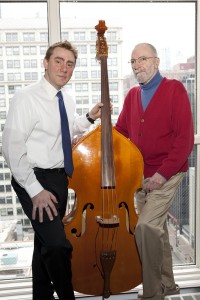 When Erik Fagrelius performed with his band, he noticed a feedback caused from vibration that generated from his double bass. It hindered listeners from enjoying the sound.
When Erik Fagrelius performed with his band, he noticed a feedback caused from vibration that generated from his double bass. It hindered listeners from enjoying the sound.
“There are a bunch of devices that could help with feedback, but nothing I was looking at was good enough,” said Fagrelius, Foundation Services Research Director, at The John Marshall Law School. “So I tried to create something on my own.”
Fagrelius created “The Insect,” using balsa wood coated in epoxy after experimenting with different material to optimize the quality and validity of his device. The piece slides under the strings to diminish the vibration tones his bass was making when the sound bounced off people and objects in a small concert hall setting.
Fagrelius’s grandfather was an inventor who died before he had the opportunity to patent his inventions.
“My inspiration was my grandfather,” Fagrelius notes. In the same way, Fagrelius hopes to pass his knowledge and desire to create to his two sons. “I see the value in the patent system.”
In fall 2009, after three years of experimenting, he brought a prototype of the Insect to the Patent Law Clinic at John Marshall. The Clinic offers services to inventors and gives John Marshall students hands-on experience in preparing and filing patent claims. When inventors bring their work to the clinic, a John Marshall faculty member accepts responsibility for pro bono patent work, and assigns students to work with the inventor. Advanced patent clinic students get a temporary license from the U.S. Patent and Trademark Office (PTO).
Don Moyer, a retired patent agent working with clinic students, and attorney David Bremer, assigned student Miri Yoon (JD ’11) to assist Fagrelius in the application process for the Insect. Together they worked to prepare the application, and Yoon used her temporary license to file Fagrelius’s appeal to the PTO.
Fagrelius remembers getting an encouraging word from Moyer when he first showed him his invention. “The more we worked on it, I began to think more and more of it,” Moyer said, of the Insect.
“Don helped me realize the true invention was the adjustability,” Fagrelius said. The device can be mounted in such a way that it will allow musicians to adjust it to any string instrument.
According to Moyer, the typical wait-time between filing a patent application and getting a PTO response is 20 months. Most requests are turned down. Fagrelius got PTO approval in approximately 10 months. When Fagrelius got his letter, Moyer was shocked—such a short response time is “unheard of.”
Though Fagrelius knew his device had potential, he credits the patent clinic for helping him get his invention recognized.
“It was an effort of four people,” Fagrelius noted. “It’s a long, arduous task to file a patent. I owe so much to the clinic and to Don Moyer.”
Fagrelius holds the joint patent with Moyer, and after he perfects the third prototype of the Insect, he plans to shop the creation to different amplifier companies for lease or for purchase.
He is currently working on his second invention, which he describes as “more universal” than the Insect, because it could be used by guitar and bass players.

